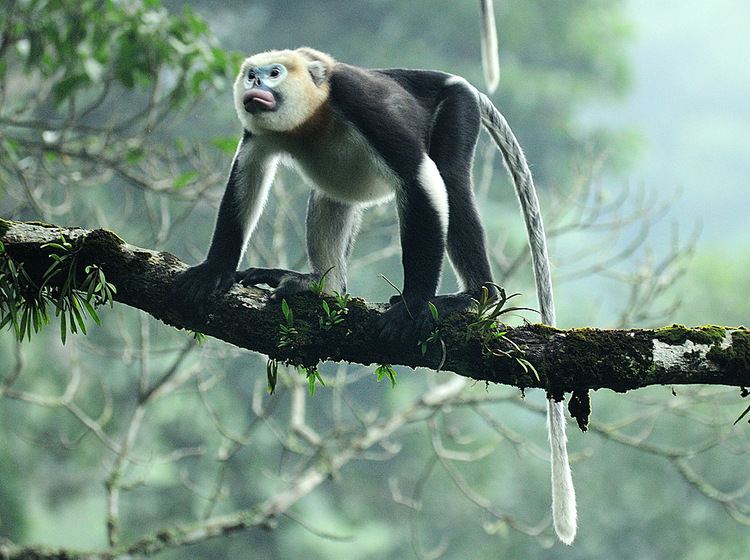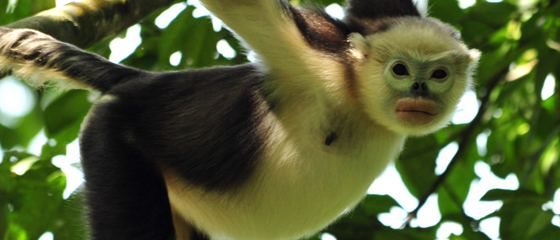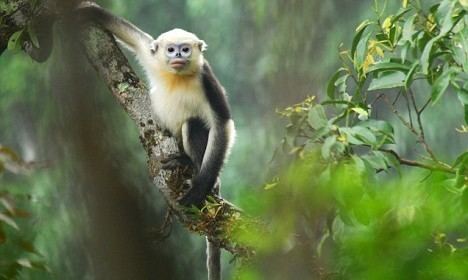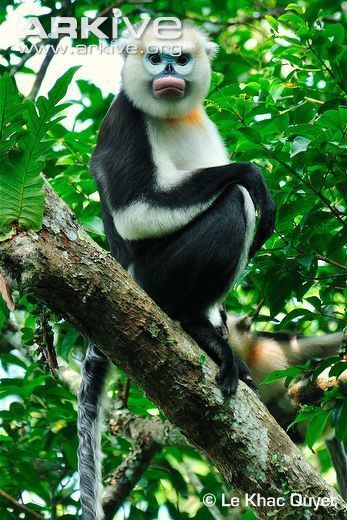Genus Rhinopithecus Higher classification Snub-nosed monkey | Phylum Chordata Family Cercopithecidae Scientific name Rhinopithecus avunculus Rank Species | |
 | ||
Similar Snub‑nosed monkey, Primate, Mammal, Douc, Golden snub‑nosed monkey | ||
The Tonkin snub-nosed monkey or Dollman's snub-nosed monkey (Rhinopithecus avunculus) is a slender-bodied arboreal Old World monkey, endemic to northern Vietnam. It is a black and white monkey with a pink nose and lips and blue patches round the eyes. It is found at altitudes of 200 to 1,200 m (700 to 3,900 ft) on fragmentary patches of forest on craggy limestone areas. First described in 1912, the monkey was rediscovered in 1990 but is exceedingly rare. In 2008, fewer than 250 individuals were thought to exist, and the species was the subject of intense conservation effort. The main threats faced by these monkeys are habitat loss and hunting, and the International Union for Conservation of Nature has rated the species as "critically endangered".
Contents

Rare and previously unseen tonkin snub nosed monkey footage
Description

The Tonkin snub-nosed monkey has a flattened face with a pink upturned nose, thickened pink lips and areas of blue skin around its eyes. The upper parts are black, the underparts creamy-white and there is an orange patch on the throat, particularly obvious in breeding males. The tail has a white tip. Its head-and-body length is 51 to 65 cm (20 to 26 in) and its tail 66 to 92 cm (26 to 36 in). Females weigh about 8 kg (18 lb) while males weigh 14 kg (31 lb). Juveniles are grey rather than black and lack the orange throat patch.
Biology

The Tonkin snub-nosed monkey is diurnal and its diet consists of a range of leaves, fruits, flowers and seeds. It moves about the canopy in small groups.
Status

Recorded at elevations between 200 and 1,200 m, its distribution is currently restricted to small fragmented tropical evergreen forests associated with steep karst limestone hills and mountains. Five isolated extant populations have been identified since its rediscovery. Despite being heralded as a flagship species and subsequently receiving international attention and conservation actions, the population trend is still declining; therefore causing it to be continuously listed as one of "The World's 25 Most Endangered Primates." since the first global non-human primate biennial assessment began in 2001.

Habitat loss and hunting are some of the major causes for declines of naturally occurring populations of non-human primates, including the Tonkin Snub-nosed monkey. Decades of expanding human population and increasing demands for scarce agriculturally viable lands have led to the loss and fragmentation of the monkey's habitats. However, habitats of known Tonkin snub-nosed monkey populations were long lost and fragmented prior to their rediscovery. A pioneering study in 1993, in Na Hang Nature Reserve, obtained a population count of 72 individuals (estimated 80), and a subsequent study at the same site in 2005 obtained a population count of 17 individuals (estimated 22). Evidenced by both primary and secondary data, the population decline within that 13-year period can only be attributed to hunting activities.
Sightings of the monkey have become increasingly rare. The primate was thought to be extinct until the 1990s, when a small population was discovered in Na Hang District in Tuyên Quang Province of Vietnam. Heavy poaching for food as well as the wildlife black market and the destruction of habitat are the main reasons why the Tonkin snub-nosed monkey is considered one of the planet's most critically endangered primate species . By 2008, when a small population with three infants was discovered in a remote forest, fewer than 250 of the primates were thought to exist. In December 2013, Fauna & Flora international released the result of a population survey conducted between September and October of that year in the Khau Ca Species and Habitat Conservation Area, Ha Giang province, Vietnam. The survey identified between 108-113 individuals alive in the conservation zone, nearly half of the standing estimate for world population and the highest number at the site since populations began to be monitored. Researchers took this as an encouraging sign that conservation efforts were making an impact on the species' steeply declining numbers.
